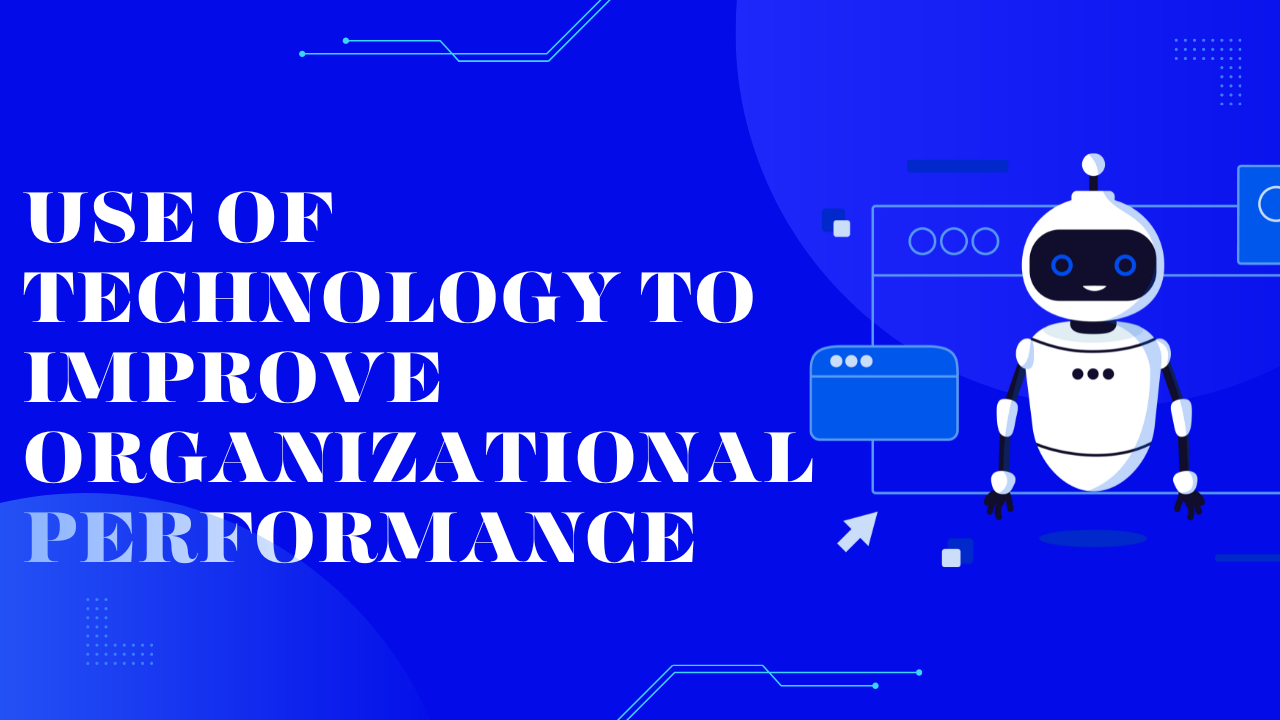Technology has transformed the way organizations operate, offering tools and solutions that streamline processes, boost productivity, and foster innovation. From automation and data analytics to communication platforms and artificial intelligence, the impact of technology on organizational performance is profound and multifaceted. This article delves into the key areas where technology can be harnessed to enhance performance, providing practical examples and strategies for implementation.
Automation
Benefits of Automation in Organizations
Automation involves using technology to perform tasks that were previously done manually. This can range from simple administrative functions to complex processes across various departments. The primary benefits of automation include increased efficiency, reduced errors, and cost savings.
1. Increased Efficiency: Automation tools can handle repetitive tasks such as data entry, invoice processing, and scheduling, freeing up employees to focus on more strategic activities. For example, Customer Relationship Management (CRM) systems automate customer data management, allowing sales teams to track interactions and streamline follow-ups without manual intervention.
2. Reduced Errors: Manual processes are prone to human error, which can lead to costly mistakes. Automation minimizes these risks by ensuring consistency and accuracy. For instance, automated financial systems reduce the likelihood of accounting errors and discrepancies.
3. Cost Savings: By automating routine tasks, organizations can reduce labor costs and allocate resources more effectively. For instance, automated marketing tools can manage email campaigns and social media posts, reducing the need for dedicated personnel.
Implementing Automation Tools
To successfully implement automation, organizations should:
- Identify Repetitive Tasks: Analyze workflows to identify tasks that are repetitive and time-consuming. Prioritize these for automation.
- Select the Right Tools: Choose automation tools that align with your organization’s needs. For example, if you need to automate customer service, consider chatbots or automated ticketing systems.
- Train Employees: Ensure that employees are trained to use new automation tools effectively. This will help in smooth adoption and minimize resistance to change.

Data Analytics
The Power of Data Analytics in Performance Improvement
Data analytics involves collecting, analyzing, and interpreting data to make informed decisions. By leveraging data analytics, organizations can gain valuable insights into various aspects of their operations, leading to improved performance and strategic advantage.
1. Enhanced Decision-Making: Data analytics provides a comprehensive view of organizational performance, allowing leaders to make data-driven decisions. For example, analyzing sales data can reveal trends and patterns that inform product development and marketing strategies.
2. Improved Customer Insights: Data analytics helps organizations understand customer preferences and behaviors. This information can be used to tailor products and services to better meet customer needs, enhancing satisfaction and loyalty.
3. Operational Efficiency: By analyzing operational data, organizations can identify inefficiencies and areas for improvement. For instance, data analytics can help optimize supply chain management by predicting demand and managing inventory levels more effectively.

Implementing Data Analytics Solutions
To harness the power of data analytics, organizations should:
- Invest in Data Management Systems: Implement robust data management systems to collect, store, and analyze data. This includes tools for data visualization, reporting, and forecasting.
- Develop a Data-Driven Culture: Encourage a culture where data-driven decision-making is valued. Train employees to use data analytics tools and interpret data effectively.
- Ensure Data Quality: Ensure that the data collected is accurate and relevant. Implement data quality checks and validations to maintain the integrity of the data.
Communication Technologies
Advancements in Communication Technologies
Effective communication is crucial for organizational success, and advancements in communication technologies have made it easier for teams to collaborate and stay connected. Modern communication tools offer features that enhance collaboration, streamline workflows, and improve overall performance.
1. Unified Communication Platforms: Platforms like Microsoft Teams and Slack integrate various communication channels, including messaging, video conferencing, and file sharing. This centralization improves collaboration and reduces the need for multiple tools.
2. Remote Collaboration Tools: With the rise of remote work, tools such as Zoom and Trello facilitate collaboration across different locations. These tools enable teams to work together in real time, regardless of geographical barriers.
3. Project Management Software: Tools like Asana and Monday.com help manage projects by tracking progress, assigning tasks, and setting deadlines. This ensures that projects are completed on time and within scope.

Implementing Communication Technologies
To leverage communication technologies effectively, organizations should:
- Choose the Right Tools: Select communication tools that align with your organization’s needs and workflow. Consider factors such as scalability, integration capabilities, and user-friendliness.
- Encourage Adoption: Promote the use of communication technologies among employees. Provide training and support to help them adapt to new tools.
- Monitor and Evaluate: Regularly assess the effectiveness of communication tools and make adjustments as needed. Solicit feedback from users to identify areas for improvement.
Artificial Intelligence and Machine Learning
The Impact of AI and ML on Organizational Performance
Artificial Intelligence (AI) and Machine Learning (ML) are transformative technologies that drive innovation and efficiency across various industries. By leveraging AI and ML, organizations can automate complex tasks, enhance decision-making, and gain a competitive edge.
1. Process Automation: AI and ML can automate complex processes such as predictive maintenance, fraud detection, and customer service. For instance, AI-powered chatbots can handle customer inquiries, providing quick and accurate responses.
2. Data Analysis and Insights: AI and ML algorithms can analyze vast amounts of data to identify patterns and trends that may not be apparent through traditional methods. This helps organizations make more informed decisions and develop strategies based on data-driven insights.
3. Personalization: AI and ML can be used to create personalized experiences for customers. For example, recommendation engines on e-commerce platforms suggest products based on past purchases and browsing behavior.

Implementing AI and ML Solutions
To effectively implement AI and ML, organizations should:
- Define Use Cases: Identify specific areas where AI and ML can add value. This could include customer service, marketing, or operations.
- Invest in Infrastructure: Ensure that your organization has the necessary infrastructure to support AI and ML initiatives. This includes computing power, data storage, and software tools.
- Develop Expertise: Build or acquire expertise in AI and ML to develop and manage these technologies. Consider partnering with AI solution providers or hiring specialists.
Cybersecurity
The Importance of Cybersecurity in Organizational Performance
As organizations increasingly rely on technology, cybersecurity has become a critical aspect of maintaining performance and protecting assets. Effective cybersecurity measures safeguard data, prevent breaches, and ensure the integrity of systems.
1. Data Protection: Implementing robust cybersecurity measures helps protect sensitive data from unauthorized access and breaches. This is essential for maintaining customer trust and compliance with regulations.
2. System Integrity: Cybersecurity measures ensure the integrity of systems by preventing malware, ransomware, and other malicious attacks. This helps maintain operational continuity and minimizes disruptions.
3. Risk Management: A proactive approach to cybersecurity involves identifying and mitigating risks before they impact performance. Regular security assessments and updates are crucial for staying ahead of potential threats.

Implementing Cybersecurity Measures
To enhance cybersecurity, organizations should:
- Adopt Comprehensive Security Policies: Develop and enforce security policies that address various aspects of cybersecurity, including access controls, data encryption, and incident response.
- Invest in Security Tools: Utilize security tools such as firewalls, antivirus software, and intrusion detection systems to protect against threats.
- Educate Employees: Provide regular training on cybersecurity best practices to employees. This includes recognizing phishing attempts, managing passwords, and reporting suspicious activity.
Cloud Computing
Advantages of Cloud Computing for Organizations
Cloud computing offers scalable and flexible solutions that enhance organizational performance by providing on-demand access to computing resources and services.
1. Scalability: Cloud computing allows organizations to scale resources up or down based on demand. This flexibility ensures that organizations can handle varying workloads without investing in physical infrastructure.
2. Cost Efficiency: By using cloud services, organizations can reduce costs associated with maintaining and upgrading on-premises hardware. Cloud providers typically offer pay-as-you-go pricing models, which can be more cost-effective.
3. Accessibility: Cloud computing enables remote access to applications and data, facilitating collaboration and productivity regardless of location. This is particularly beneficial for organizations with distributed teams or remote workers.

Implementing Cloud Computing Solutions
To effectively leverage cloud computing, organizations should:
- Choose the Right Cloud Service Model: Decide between public, private, or hybrid cloud models based on your organization’s needs and security requirements.
- Select a Reliable Provider: Choose a reputable cloud service provider with a proven track record of reliability, security, and support.
- Monitor and Optimize: Regularly monitor cloud usage and performance to optimize costs and ensure that resources are used efficiently.
Technologies and Their Impact on Organizational Performance
| Technology | Key Benefits | Implementation Tips |
|---|---|---|
| Automation | Invest in data management systems, develop a data-driven culture, and ensure data quality | Identify tasks for automation, choose tools, train employees |
| Data Analytics | Enhanced decision-making, improved customer insights, operational efficiency | Invest in data management systems, develop a data-driven culture, ensure data quality |
| Communication Technologies | Improved collaboration, streamlined workflows, enhanced connectivity | Choose suitable tools, encourage adoption, monitor effectiveness |
| Artificial Intelligence & Machine Learning | Process automation, data analysis, personalization | Define use cases, invest in infrastructure, develop expertise |
| Cybersecurity | Data protection, system integrity, risk management | Adopt comprehensive policies, invest in security tools, educate employees |
| Cloud Computing | Scalability, cost efficiency, accessibility | Choose the right service model, select a reliable provider, monitor and optimize |
FAQs
1. What are the main benefits of using automation in organizations?
Automation increases efficiency, reduces errors, and saves costs by performing repetitive tasks and streamlining processes.
2. How can data analytics improve decision-making?
Data analytics provides insights into organizational performance, customer behavior, and operational efficiency, enabling data-driven decisions.
3. What are some examples of communication technologies that enhance collaboration?
Unified communication platforms like Microsoft Teams, remote collaboration tools like Zoom, and project management software like Asana improve team collaboration and connectivity.
4. How does AI and ML contribute to organizational performance?
AI and ML automate complex tasks, provide data-driven insights, and enable personalized customer experiences, driving innovation and efficiency.
5. Why is cybersecurity important for organizations?
Cybersecurity protects data and systems from unauthorized access and threats, ensuring operational continuity and maintaining customer trust.
6. What are the advantages of cloud computing for businesses?
Cloud computing offers scalability, cost efficiency, and remote access, enabling organizations to manage resources flexibly and reduce infrastructure costs.
7. How can organizations effectively implement new technologies?
Organizations should identify specific needs, choose suitable tools, provide training, and regularly monitor and evaluate the effectiveness of the technology.
8. What are some best practices for ensuring data quality in analytics?
Best practices include validating data sources, implementing data quality checks, and maintaining data integrity throughout the collection and analysis process.
Final Thoughts
The integration of technology into organizational processes is not merely an option but a necessity for achieving superior performance. From automation and data analytics to AI, cybersecurity, and cloud computing, each technological advancement offers unique benefits that can drive efficiency, innovation, and strategic advantage. By carefully selecting and implementing the right technologies, organizations can enhance their operations, respond to market demands more effectively, and maintain a competitive edge in an increasingly digital world.


















4 thoughts on “Use of Technology to Improve Organizational Performance”